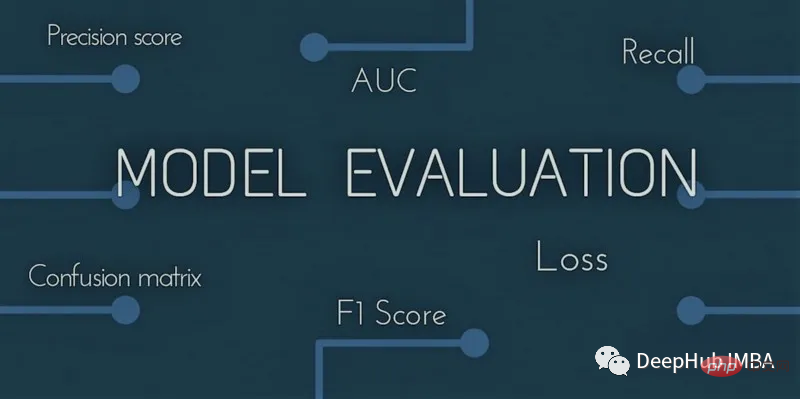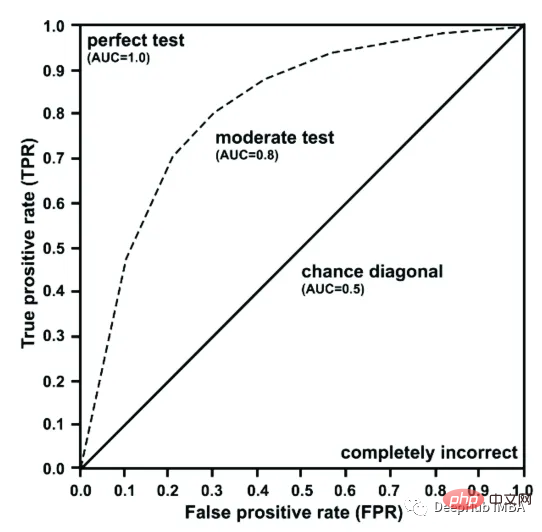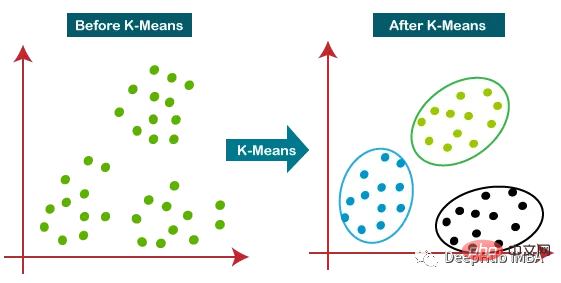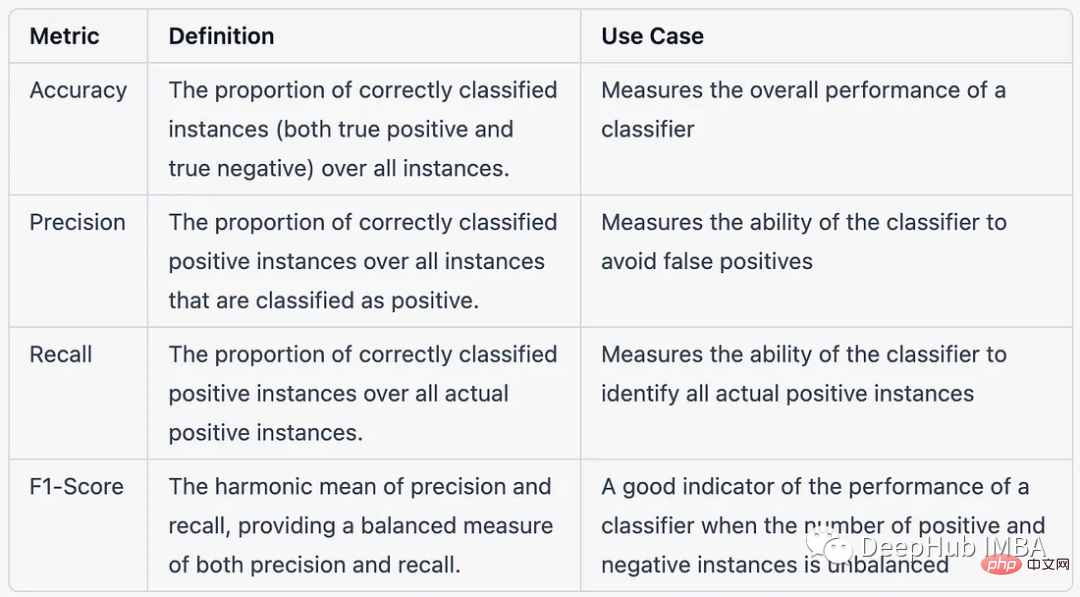 Technology peripherals
Technology peripherals
 AI
AI
 Ten common interview questions for machine learning evaluation metrics
Ten common interview questions for machine learning evaluation metrics
Ten common interview questions for machine learning evaluation metrics
Evaluation metrics are quantitative metrics used to evaluate the performance of machine learning models. They provide a systematic and objective way to compare different models and measure their success in solving a specific problem. By comparing the results of different models and evaluating their performance, you can make the right decisions about which models to use, how to improve existing models, and how to optimize the performance of a given task, so evaluation metrics play a vital role in the development and deployment of machine learning models. crucial role. Therefore, evaluation indicators are basic questions that are often asked during interviews. This article has compiled 10 common questions.

1. Can you explain the difference between precision and recall in the context of machine learning?
In machine learning models, precision and Recall are two commonly used evaluation metrics. Precision is a measure of the number of true positive predictions made by a model out of all positive predictions, indicating the model's ability to avoid false positive predictions.
Precision = TP/TP FP
Recall is a measure of the number of true predictions a model makes across all actual positive instances in the dataset. Recall represents the model's ability to correctly identify all positive instances.
Recall = TP/TP FN
Precision and recall are both important evaluation metrics, but the trade-off between the two depends on the requirements of the specific problem to be solved. For example, in medical diagnosis, recall may be more important because it is crucial to identify all cases of a disease, even if this results in a higher false positive rate. But in fraud detection, precision may be more important, as avoiding false accusations is crucial, even if this results in a higher false negative rate.
2. How to choose an appropriate evaluation metric for a given problem?
Selecting an appropriate evaluation for a given problem is a key aspect of the model development process. When selecting indicators, it is important to consider the nature of the problem and the goals of the analysis. Some common factors to consider include:
Problem type: Is it a binary classification problem, a multi-class classification problem, a regression problem, or something else?
Business goal: What is the ultimate goal of the analysis, What performance is required? For example, if the goal is to minimize false negatives, recall will be a more important metric than precision.
Dataset characteristics: Are the classes balanced or unbalanced? Is the data set large or small?
Data quality: What is the quality of the data, and how much noise is present in the data set?
Based on these factors, you can choose an evaluation index, such as accuracy, F1-score, AUC-ROC, Precision-Recall, mean square error, etc. But it is common to use multiple evaluation metrics to gain a complete understanding of model performance.
3. Can you introduce the use of F1 score?
F1 score is a commonly used evaluation indicator in machine learning, used to balance precision and recall. Precision measures the proportion of positive observations out of all positive predictions made by the model, while recall measures the proportion of positive predictions out of all actual positive observations. The F1 score is the harmonic mean of precision and recall and is often used as a single metric to summarize the performance of a binary classifier.
F1 = 2 * (Precision * Recall) / (Precision Recall)
In situations where a model must make a trade-off between precision and recall, the F1 score is better than using precision or recall alone Recall provides a more granular performance assessment. For example, in cases where false positive predictions are more costly than false negative predictions, optimizing precision may be more important, whereas in cases where false negative predictions are more costly, recall may be prioritized. The F1 score can be used to evaluate the performance of the model in these scenarios and provide corresponding data support on how to adjust its threshold or other parameters to optimize performance.
4. Can you explain the reason for using the ROC curve in model evaluation?
The ROC curve is a graphical representation of the performance of a binary classification model that plots the true positive rate (TPR) vs. False positive rate (FPR). It helps evaluate the trade-off between sensitivity (true positives) and specificity (true negatives) of a model, and is widely used to evaluate models that make predictions based on binary classification outcomes (such as yes or no, pass or fail, etc.).

#The ROC curve measures the performance of a model by comparing its predicted results with the actual results. A good model has a large area under the ROC curve, which means it is able to accurately distinguish between positive and negative classes. ROC AUC (Area Under the Curve, area under the curve) is used to compare the performance of different models, especially a good way to evaluate model performance when classes are imbalanced.
5. How to determine the optimal threshold for a binary classification model?
The optimal threshold for a binary classification model is determined by finding a threshold that balances precision and recall. This can be achieved by using evaluation metrics such as F1 score, which balances accuracy and recall, or using ROC curves, which plots the true positive and false positive rates for various thresholds. The optimal threshold is usually chosen as the point on the ROC curve closest to the upper left corner, because this maximizes the true positive rate while minimizing the false positive rate. In practice, the optimal threshold may also depend on the specific goals of the problem and the costs associated with false positives and false negatives.
6. Can you introduce the following trade-off between precision and recall in model evaluation?
The trade-off between precision and recall in model evaluation refers to correctly identifying positive instances (recall rate) and correctly identifying only positive instances (recall). High precision means a low number of false positives, while a high recall means a low number of false negatives. For a given model, it is often impossible to maximize precision and recall simultaneously. To make this trade-off, one needs to consider the specific goals and needs of the problem and choose an evaluation metric that is consistent with them.
7. How to evaluate the performance of the clustering model?
The performance of the clustering model can be evaluated using many indicators. Some common metrics include:
- Silhouette Score: It measures the similarity of observed own cluster compared to other clusters. Scores range from -1 to 1, with values closer to 1 indicating stronger clustering structure.
- Calinski-Harabasz index: It measures the ratio of between-cluster variance to within-cluster variance. Higher values indicate better clustering solutions.
- Davies-Bouldin Index: It measures the average similarity between each cluster and its most similar cluster. Smaller values indicate better clustering solutions.
- Adjusted Rand Index: It measures the similarity between the true class labels and the predicted cluster labels, adjusted based on probability. Higher values indicate better clustering solutions.
- Confusion Matrix: It can evaluate the accuracy of a clustering model by comparing the predicted clusters with the true classes.

#But choosing an appropriate evaluation metric also depends on the specific problem and the goals of the cluster analysis.
8. In the context of multi-class classification problems, the differences between accuracy, precision, recall, and F1-score
The following is in the context of multi-class classification problems, in tabular form Compare accuracy, precision, recall, and F1-score:

9. How to evaluate the performance of the recommendation system?
Evaluating the performance of the recommendation system includes measuring the system Effectiveness and efficiency in recommending relevant items to users. Some commonly used metrics for evaluating recommendation system performance include:
- Precision: The proportion of recommended items that are relevant to the user.
- Recall: The proportion of related items recommended by the system.
- F1-Score: The harmonic mean of precision and recall.
- Mean Average Precision (MAP): A measure of the average precision of the overall users of a recommendation system.
- Normalized Discounted Cumulative Gain (NDCG): Measures the rank-weighted relevance of recommended items.
- Root Mean Square Error (RMSE): A measure of the difference between predicted and actual ratings for a set of items.
- 10. How to deal with unbalanced data sets when evaluating model performance?
In order to deal with unbalanced data sets in model evaluation, the following techniques can be used:

- Resample the dataset: Oversample the minority class or oversample the majority class to balance the class distribution.
- Use different evaluation metrics: Metrics such as precision, recall, F1-score, and area under the ROC curve (AUC-ROC) are sensitive to class imbalance and can better understand the performance of the model on imbalanced data. set performance.
- Use cost-sensitive learning: assign costs to different types of misclassification, such as assigning a higher cost to false negatives than false positives, to make the model more sensitive to minority classes.
- Use ensemble methods: By combining the results of multiple models, techniques such as bagging, boosting, and stacking can be used to improve model performance on imbalanced data sets.
- Hybrid methods: A combination of the above techniques can be used to handle imbalanced data sets in model evaluation.
Summary
Evaluation metrics play a key role in machine learning. Choosing the right evaluation metric and using it appropriately are critical to ensuring the quality and performance of machine learning models and the insights they generate. Reliability is crucial. Because it will definitely be used, this is a question that is often asked in interviews. I hope the questions compiled in this article will be helpful to you.
The above is the detailed content of Ten common interview questions for machine learning evaluation metrics. For more information, please follow other related articles on the PHP Chinese website!

Hot AI Tools

Undresser.AI Undress
AI-powered app for creating realistic nude photos

AI Clothes Remover
Online AI tool for removing clothes from photos.

Undress AI Tool
Undress images for free

Clothoff.io
AI clothes remover

Video Face Swap
Swap faces in any video effortlessly with our completely free AI face swap tool!

Hot Article

Hot Tools

Notepad++7.3.1
Easy-to-use and free code editor

SublimeText3 Chinese version
Chinese version, very easy to use

Zend Studio 13.0.1
Powerful PHP integrated development environment

Dreamweaver CS6
Visual web development tools

SublimeText3 Mac version
God-level code editing software (SublimeText3)

Hot Topics
 1387
1387
 52
52
 15 recommended open source free image annotation tools
Mar 28, 2024 pm 01:21 PM
15 recommended open source free image annotation tools
Mar 28, 2024 pm 01:21 PM
Image annotation is the process of associating labels or descriptive information with images to give deeper meaning and explanation to the image content. This process is critical to machine learning, which helps train vision models to more accurately identify individual elements in images. By adding annotations to images, the computer can understand the semantics and context behind the images, thereby improving the ability to understand and analyze the image content. Image annotation has a wide range of applications, covering many fields, such as computer vision, natural language processing, and graph vision models. It has a wide range of applications, such as assisting vehicles in identifying obstacles on the road, and helping in the detection and diagnosis of diseases through medical image recognition. . This article mainly recommends some better open source and free image annotation tools. 1.Makesens
 This article will take you to understand SHAP: model explanation for machine learning
Jun 01, 2024 am 10:58 AM
This article will take you to understand SHAP: model explanation for machine learning
Jun 01, 2024 am 10:58 AM
In the fields of machine learning and data science, model interpretability has always been a focus of researchers and practitioners. With the widespread application of complex models such as deep learning and ensemble methods, understanding the model's decision-making process has become particularly important. Explainable AI|XAI helps build trust and confidence in machine learning models by increasing the transparency of the model. Improving model transparency can be achieved through methods such as the widespread use of multiple complex models, as well as the decision-making processes used to explain the models. These methods include feature importance analysis, model prediction interval estimation, local interpretability algorithms, etc. Feature importance analysis can explain the decision-making process of a model by evaluating the degree of influence of the model on the input features. Model prediction interval estimate
 Identify overfitting and underfitting through learning curves
Apr 29, 2024 pm 06:50 PM
Identify overfitting and underfitting through learning curves
Apr 29, 2024 pm 06:50 PM
This article will introduce how to effectively identify overfitting and underfitting in machine learning models through learning curves. Underfitting and overfitting 1. Overfitting If a model is overtrained on the data so that it learns noise from it, then the model is said to be overfitting. An overfitted model learns every example so perfectly that it will misclassify an unseen/new example. For an overfitted model, we will get a perfect/near-perfect training set score and a terrible validation set/test score. Slightly modified: "Cause of overfitting: Use a complex model to solve a simple problem and extract noise from the data. Because a small data set as a training set may not represent the correct representation of all data." 2. Underfitting Heru
 Transparent! An in-depth analysis of the principles of major machine learning models!
Apr 12, 2024 pm 05:55 PM
Transparent! An in-depth analysis of the principles of major machine learning models!
Apr 12, 2024 pm 05:55 PM
In layman’s terms, a machine learning model is a mathematical function that maps input data to a predicted output. More specifically, a machine learning model is a mathematical function that adjusts model parameters by learning from training data to minimize the error between the predicted output and the true label. There are many models in machine learning, such as logistic regression models, decision tree models, support vector machine models, etc. Each model has its applicable data types and problem types. At the same time, there are many commonalities between different models, or there is a hidden path for model evolution. Taking the connectionist perceptron as an example, by increasing the number of hidden layers of the perceptron, we can transform it into a deep neural network. If a kernel function is added to the perceptron, it can be converted into an SVM. this one
 The evolution of artificial intelligence in space exploration and human settlement engineering
Apr 29, 2024 pm 03:25 PM
The evolution of artificial intelligence in space exploration and human settlement engineering
Apr 29, 2024 pm 03:25 PM
In the 1950s, artificial intelligence (AI) was born. That's when researchers discovered that machines could perform human-like tasks, such as thinking. Later, in the 1960s, the U.S. Department of Defense funded artificial intelligence and established laboratories for further development. Researchers are finding applications for artificial intelligence in many areas, such as space exploration and survival in extreme environments. Space exploration is the study of the universe, which covers the entire universe beyond the earth. Space is classified as an extreme environment because its conditions are different from those on Earth. To survive in space, many factors must be considered and precautions must be taken. Scientists and researchers believe that exploring space and understanding the current state of everything can help understand how the universe works and prepare for potential environmental crises
 Implementing Machine Learning Algorithms in C++: Common Challenges and Solutions
Jun 03, 2024 pm 01:25 PM
Implementing Machine Learning Algorithms in C++: Common Challenges and Solutions
Jun 03, 2024 pm 01:25 PM
Common challenges faced by machine learning algorithms in C++ include memory management, multi-threading, performance optimization, and maintainability. Solutions include using smart pointers, modern threading libraries, SIMD instructions and third-party libraries, as well as following coding style guidelines and using automation tools. Practical cases show how to use the Eigen library to implement linear regression algorithms, effectively manage memory and use high-performance matrix operations.
 Five schools of machine learning you don't know about
Jun 05, 2024 pm 08:51 PM
Five schools of machine learning you don't know about
Jun 05, 2024 pm 08:51 PM
Machine learning is an important branch of artificial intelligence that gives computers the ability to learn from data and improve their capabilities without being explicitly programmed. Machine learning has a wide range of applications in various fields, from image recognition and natural language processing to recommendation systems and fraud detection, and it is changing the way we live. There are many different methods and theories in the field of machine learning, among which the five most influential methods are called the "Five Schools of Machine Learning". The five major schools are the symbolic school, the connectionist school, the evolutionary school, the Bayesian school and the analogy school. 1. Symbolism, also known as symbolism, emphasizes the use of symbols for logical reasoning and expression of knowledge. This school of thought believes that learning is a process of reverse deduction, through existing
 Explainable AI: Explaining complex AI/ML models
Jun 03, 2024 pm 10:08 PM
Explainable AI: Explaining complex AI/ML models
Jun 03, 2024 pm 10:08 PM
Translator | Reviewed by Li Rui | Chonglou Artificial intelligence (AI) and machine learning (ML) models are becoming increasingly complex today, and the output produced by these models is a black box – unable to be explained to stakeholders. Explainable AI (XAI) aims to solve this problem by enabling stakeholders to understand how these models work, ensuring they understand how these models actually make decisions, and ensuring transparency in AI systems, Trust and accountability to address this issue. This article explores various explainable artificial intelligence (XAI) techniques to illustrate their underlying principles. Several reasons why explainable AI is crucial Trust and transparency: For AI systems to be widely accepted and trusted, users need to understand how decisions are made



